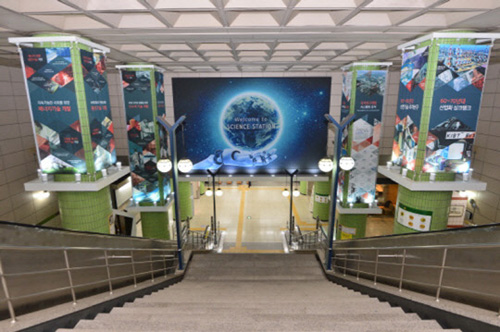Toward hospital, shooting zone & museum…Subway in ‘limitless change’
Park Sang Gil | sweatsk@ | 2017-09-19 09:50:29

Entrance of Science Station of Sangwolgok Station. Photo by Seoul City
The subway station is about to reborn as a one-stop complex cultural space. It is transforming into a family theme space as well as a place where you can shoot TV commercials, music videos, and independent films.
According to the Seoul Metropolitan Transportation Corporation on September 18, 390 video images were filmed in the main history of Seoul subway for the past year. There were 20 commercial videos including TV dramas and commercials, music videos and commercials, and 370 non-commercial films including independent films, student films, and current affairs education. There are many non-profit videos because there is no space rental fee. The corporation has not received a filming fee for movies, movies, news videos, UCC sightseeing, and home videos produced for independent films, student films, and other public purposes. However, if the number of shooters is more than 15 or the shooting time exceeds 3 hours. It will be charged at half the basic fee.
For commercial movies such as feature films, TV dramas, entertainment and music videos for theaters, 300,000 won for 2 hours for major facilities such as the waiting room, the situation of driving electric vehicles, major congested stations such as Gangnam Station, KRW 500,000 for two hours of transferring stations, and two hours and three hundred thousand won for construction and historical office space. In areas where access by outsiders such as vehicles or engine rooms is prohibited, photography should be allowed only after consultation. Over the past year, commissions for commercial video footage in the history amounted to KRW 22.73 million.
From January this year, the first clinic in the subway history opened in Sangam Digital Media City Station (DMC, Line # 6) in Seoul, and it offers differentiated services from general hospitals, clinics and pharmacies that do not operate at night or on holidays. The hospital is open from 10:00 am to 11:00 pm on weekdays, and from 10:00 am to 6:00 pm on Saturdays, Sundays and holidays. In the case of the pharmacy, it is open from 9:00 am to 10:00 pm on weekdays, and from 9:00 am to 5:00 pm on Saturdays, Sundays and holidays.
Besides, eleven places, including Sekmun Station (Line 4), Sangwolgok Station (Line 6) and Hyehwa Station (Line 4), are being transformed into family theme spaces. At the top of the entrance of Ssangmun Station No. 4, people can easily locate the station from a distance by arranging the guitars and dolls and friends` sculptures. The Changwolgok station on line 6 was renovated into a history of science themes. Sangwolgok Station No.1 & Exit No.4 and the Science Station, which is located on the first to third floors of the basement, was designed as a space where various scientists can interact with students and citizens, and a place where children and youth are interested in science. There is a small lecture hall where students can discuss science topics, a bio-living lab to experience biomedical research achievements, and an interactive month that attracts interest through interaction with spectator behavior. Scientists and businessmen who introduce famous achievements and life John was prepared.
Meanwhile, there are also Hyehwa Station (theater), Gyeongbokgung Station (Line 3 and Art Gallery), Noksapyeong Station (Line 6 and Art) and Gasan Digital Dance Zone (Line 1 and G Valley). It will be operated as a belt. Kim Tae-ho, the head of the Seoul Transportation Corporation in addition to utilizing them as individual theme spaces, is currently in the process of issuing a second store to the Gangdong-gu office starting with the first branch of the DMC bottle, and said, "The subway has become a one-stop complex cultural space, I will do it. "
By Park Sang Gil sweatsk@
